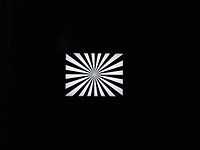Siemens star

A Siemens star is a device used to test the resolution of optical instruments, printers and displays. It consists of a pattern of bright "spokes" on a dark background, which radiate from a common center and become wider as they get further from it. Theoretically the spokes only meet at the exact center of the star; the spokes and the gaps between them become narrower the closer to the center one looks, but they never touch except at the center. When printed or displayed on a device with limited resolution, however, the spokes appear to touch at some distance from the center. The smallest gap visible is limited by the smallest dot of ink the printer can produce, making the Siemens star a useful tool for comparing two printers' resolutions (DPI). Similarly, it can be applied to a camera's optical resolution by taking photographs of a Siemens star printed at high resolution and comparing photographs from different cameras to see which retained the center detail the closest.

Siemens stars are similar to the sunburst pattern used as a background in graphic design, as in the Japanese Naval Ensign. They are useful in drawing the eye to a point on the page.
External links
- ISO 15775 chart (pdf) resolution test chart featuring a vector siemens star